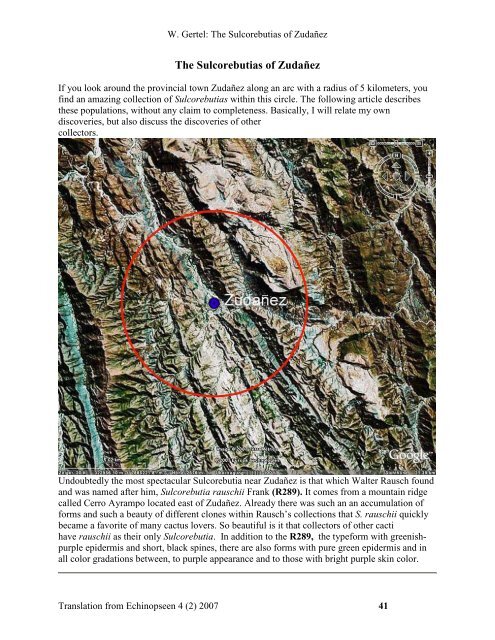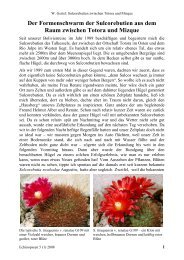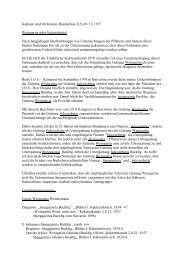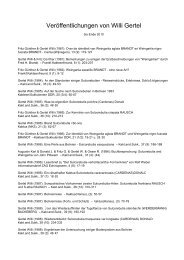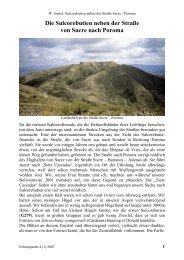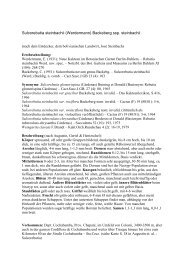The Sulcorebutias of Zudañez
The Sulcorebutias of Zudañez
The Sulcorebutias of Zudañez
Create successful ePaper yourself
Turn your PDF publications into a flip-book with our unique Google optimized e-Paper software.
W. Gertel: <strong>The</strong> <strong>Sulcorebutias</strong> <strong>of</strong> <strong>Zudañez</strong><br />
<strong>The</strong> <strong>Sulcorebutias</strong> <strong>of</strong> <strong>Zudañez</strong><br />
If you look around the provincial town <strong>Zudañez</strong> along an arc with a radius <strong>of</strong> 5 kilometers, you<br />
find an amazing collection <strong>of</strong> <strong>Sulcorebutias</strong> within this circle. <strong>The</strong> following article describes<br />
these populations, without any claim to completeness. Basically, I will relate my own<br />
discoveries, but also discuss the discoveries <strong>of</strong> other<br />
collectors.<br />
Undoubtedly the most spectacular Sulcorebutia near <strong>Zudañez</strong> is that which Walter Rausch found<br />
and was named after him, Sulcorebutia rauschii Frank (R289). It comes from a mountain ridge<br />
called Cerro Ayrampo located east <strong>of</strong> <strong>Zudañez</strong>. Already there was such an an accumulation <strong>of</strong><br />
forms and such a beauty <strong>of</strong> different clones within Rausch’s collections that S. rauschii quickly<br />
became a favorite <strong>of</strong> many cactus lovers. So beautiful is it that collectors <strong>of</strong> other cacti<br />
have rauschii as their only Sulcorebutia. In addition to the R289, the typeform with greenishpurple<br />
epidermis and short, black spines, there are also forms with pure green epidermis and in<br />
all color gradations between, to purple appearance and to those with bright purple skin color.<br />
Translation from Echinopseen 4 (2) 2007 41
W. Gertel: <strong>The</strong> <strong>Sulcorebutias</strong> <strong>of</strong> <strong>Zudañez</strong><br />
Looking toward <strong>Zudañez</strong> from a hill south <strong>of</strong> the Cerro Ayrampo<br />
<strong>The</strong> spine colors <strong>of</strong> S. rauschii range from black to red and yellow spines. In particular Rausch’s<br />
plant with yellow spines is a sought-after collector's item, although it has only a small and totally<br />
inconspicuous flower. <strong>The</strong> clone with tasseled flowers, and that with hairy flowers, are much<br />
sought-after collector's items too. However, it cannot be denied that the latter is no Sulcorebutia,<br />
but rather a Mediolobivia.<br />
Of course, even after Rausch many cactus lovers searched for S. rauschii and they also found<br />
it. We now know that the occurrence <strong>of</strong> this type is not limited to the two highest peaks <strong>of</strong> the<br />
Cerro Ayrampo, but that also on the slopes <strong>of</strong> the mountain there are several small populations,<br />
which apparently have no connection with each other. So it happens that in the past years, there<br />
was also found a small population, in addition to "normal" rauschiis, <strong>of</strong> plants with almost white<br />
spines (eg, G263, VZ50a), which do not really look like S. rauschii.<br />
On the mountain ranges south <strong>of</strong> the Cerro Ayrampa one finds a completely different range <strong>of</strong><br />
Sulcorebutia forms, so that anyone ascending these mountains is not able to understand the<br />
relationship among them. <strong>The</strong> first <strong>Sulcorebutias</strong> one encounters are tiny, group-forming plants<br />
with dark green, sometimes purple bodies and long, white spines (G340 and 340a). Of these<br />
plants only a few examples were known for many years under the collector’s numbers GR21 and<br />
JD330. Both are finds <strong>of</strong> Gianfranco Rovida. At times they were called S senilis or gerosenilis<br />
or until they received the name “hertusii”.<br />
Translation from Echinopseen 4 (2) 2007 42
W. Gertel: <strong>The</strong> <strong>Sulcorebutias</strong> <strong>of</strong> <strong>Zudañez</strong><br />
One <strong>of</strong> the many forms <strong>of</strong> Sulcorebutia <strong>The</strong> normal form <strong>of</strong> Sulcorebutia rauschii<br />
rauschii R289 G155a with olive-reddish epidermis<br />
Sulcorebutia rauschii G155 with light green Sulcorebutia rauschii G263 with violet epidermis<br />
epidermis<br />
Sulcorebutia rauschii G263 with light Sulcorebutia tarabucoensis ssp. hertusii JD330-7<br />
epidermis and almost white spines. - originally found by Gianfranco Rovida<br />
After several revisions the valid name is now Sulcorebutia tarabucoensis ssp. hertusii (Halda et<br />
Horáček) Gertel et Wahl (2004). This taxon, however, not only describes the typical whitehaired,<br />
sometimes yellowish hairy plants, but a variety <strong>of</strong> forms from the entire region south <strong>of</strong><br />
<strong>Zudañez</strong>. <strong>The</strong> few images can show only a small part <strong>of</strong> this wealth <strong>of</strong> forms. Some <strong>of</strong> them are<br />
without doubt the plants <strong>of</strong> the small populations which are found alongside the further ascent to<br />
the top <strong>of</strong> the mountain above the location <strong>of</strong> typical hertusiis.<br />
Translation from Echinopseen 4 (2) 2007 43
W. Gertel: <strong>The</strong> <strong>Sulcorebutias</strong> <strong>of</strong> <strong>Zudañez</strong><br />
Sulcorebutia tarabucoensis ssp. hertusii G340a - a group <strong>of</strong> densely hairy plantlets on location<br />
Sulcorebutia tarabucoensis ssp. hertusii GR21/4 Sulcorebutia tarabucoensis ssp. hertusii G341 --<br />
- <strong>The</strong> original discovery <strong>of</strong> Rovida a pale green variety, perfectly uniform in habit,<br />
which is found somewhat above the typical form<br />
Even after climbing some additinal 50 meters <strong>of</strong> altitude, where one finds only isolated<br />
<strong>Sulcorebutias</strong>, the next polulation (G341) appears significantly changed. <strong>The</strong>re are much fewer<br />
and shorter spines, and the epidermis is light green, without any shade <strong>of</strong> purple. Again, another<br />
100m higher there is a small site <strong>of</strong> <strong>Sulcorebutias</strong> with purple epidermis and relatively short,<br />
pectinate, white to amber-colored spines (G342). <strong>The</strong>se plants are still quite small, but with not<br />
nearly as many <strong>of</strong>fsets as S. hertusii itself. Another 100m later we find the trend <strong>of</strong> the last<br />
population continued. <strong>The</strong> Sulcos (G343) are now quite large - we have seen specimens <strong>of</strong> 5 cm<br />
in diameter – rarely <strong>of</strong>fsetting, and claw-like adpressed spines ranging from white to dark brown.<br />
Translation from Echinopseen 4 (2) 2007 44
W. Gertel: <strong>The</strong> <strong>Sulcorebutias</strong> <strong>of</strong> <strong>Zudañez</strong><br />
Taking into account all <strong>of</strong> intermediate forms found, they form a kind <strong>of</strong> development line and it<br />
is clear that these forms are only ecotypes <strong>of</strong> S. tarabucoensis ssp. hertusii . However, when only<br />
considering the individual small populations separately, one could easily consider them to be at<br />
least 3 different species. To increase the confusion, there is found at the top on a nearby hill,<br />
barely 100 meters from G343, a further different shape (G344) with tiny, budding bodies and<br />
very dense white, adpressed spination.<br />
corebutia spec. G342 and G343 - totally different plants, which it is hard to combine with S.<br />
tarabucoensis ssp. hertusii, but which occur only a few 100 m above<br />
Similarly variable as onthis mountain, there are different populations on every mountain range,<br />
to the south to south-west <strong>of</strong> <strong>Zudañez</strong> <strong>of</strong>f the Cordillera Mandinga. You could say that every<br />
little hill has its own distinctive Sulcorebutia population. However, I have nowhere else observed<br />
that so many different forms occur on a single mountain! Mostly all plants <strong>of</strong> a location are<br />
relatively uniform with a certain range <strong>of</strong> variation. Most <strong>of</strong> these <strong>Sulcorebutias</strong> bloom more or<br />
less bright purple.<br />
At the edge <strong>of</strong> the Cordillera Mandinga itself, where there are altitudes up to and over 3000m,<br />
one sometimes finds <strong>Sulcorebutias</strong> with yellow and red flowers, which will eliminate the last<br />
doubt about the close relationship to S. tarabucoensis. Swoboda was the first to bring to Europe<br />
the such plants with his field numbers HS125 and HS125a.<br />
North <strong>of</strong> <strong>Zudañez</strong> <strong>Sulcorebutias</strong> are known from only a few localities. Only on the northern<br />
slopes <strong>of</strong> Cerro Ayrampo were <strong>Sulcorebutias</strong> found in some places, with similarities with forms<br />
from the environment <strong>of</strong> S. tarabucoensis ssp. hertusii (G345). <strong>The</strong>se plants can hardly be<br />
distingushed from the above-mentioned G344 . Here it is interesting to know that between<br />
S. rauschii occurring in the southern area <strong>of</strong> the Cerro Ayrampo and the just mentioned Sulcos<br />
there is a zone <strong>of</strong> approximately 5 km where no <strong>Sulcorebutias</strong> have been found at all. We have<br />
observed this fact while walking across the entire ridge <strong>of</strong> Ayrampo in 1995, and several years<br />
earlier.<br />
Translation from Echinopseen 4 (2) 2007 45<br />
Sul
W. Gertel: <strong>The</strong> <strong>Sulcorebutias</strong> <strong>of</strong> <strong>Zudañez</strong><br />
Sulcorebutia spec. G344 something grows only 200m away from the G343 at the same level<br />
Hansjörg Jucker had the same experience while making the trip in the opposite direction, ie from<br />
south to north.<br />
Also within the afore-mentioned radius around <strong>Zudañez</strong>, lynig east <strong>of</strong> the Cerro Ayrampo, is the<br />
very striking Cerro Calle Calle, a massive table mountain with repellent and steep cliffs at the<br />
top. Although so unpromising, as it seems at first glance, this mountain is not barren. It is even<br />
populated, and today a pretty good road leads up and continues over large parts the summit<br />
plateau. After the road has overcome the steep walls and has reached the summit plateau, we see<br />
a little further up the small town Calle Calle. Here Alfred Lau, many years ago collected field<br />
number L389 which now carries the name Sulcorebutia tarabucoensis var callecallensis (F.<br />
Brandt) Augustin et Gertel. This plant has not been found for many years. <strong>The</strong> reason for this<br />
became clear during my 1991 and 2001 trips, when together with Erwin Herzog and Ralf<br />
Hillmann I searched for hours without success up there, and later with my wife together in<br />
several places <strong>of</strong> the mountain unsuccessfully sought for these plants. Even relatively accurate<br />
information on several sites helped us little further. Only after several hours, when we wanted to<br />
abandon the search, we found the tiny plantlets (G261), more or less by accident. Apart from<br />
their size <strong>of</strong> up to 1cm Ø, they were withdrawn totally into the ground, and there were no flowers<br />
– without a little luck, not to be found. To my knowledge is no one knows Cerro Calle Calle<br />
better than my Dutch friend Johan de Vries. He searched the summit plateau <strong>of</strong> Cerro Calle Calle<br />
during several trips and found a number <strong>of</strong> different localities.<br />
Translation from Echinopseen 4 (2) 2007 46
W. Gertel: <strong>The</strong> <strong>Sulcorebutias</strong> <strong>of</strong> <strong>Zudañez</strong><br />
Overlooking the mighty Cerro Calle Calle from neighboring Cerro Salvintayoj Khasa<br />
Also just south <strong>of</strong> <strong>Zudañez</strong> one finds Forms <strong>of</strong> Little resemblance to Sulcorebutia tarabucoensis ssp.<br />
Sulcorebutia tarabucoensis ssp hertusii (G203) hertusii, but from neighboring hills <strong>of</strong> the<br />
location <strong>of</strong> G203, to the south <strong>of</strong> <strong>Zudañez</strong><br />
From him, we know that S. tarabucoensis var callecallensis has very different forms. <strong>The</strong> wellknown<br />
forms, similar to L389 have a relatively light green epidermis with short, pectinate<br />
adpressed, bright spines. <strong>The</strong> flowers are nearly all yellow-red, some with shimmering blue tips<br />
<strong>of</strong> the petals. Some <strong>of</strong> these flowers appear to have almost three-coloured, which <strong>of</strong> course<br />
makes them particularly attractive. However, there also small populations <strong>of</strong> plants with darker,<br />
reddish shaded epidermis with almost pure red flowers (eg VZ56). Elsewhere, there are only<br />
yellow to yellow-orange-colored flowers (VZ195). Another find (VZ196) has purple flowers<br />
with yellow throat, a combination <strong>of</strong> colors which is not known to me in this manner from any<br />
other Sulcorebutia.<br />
Translation from Echinopseen 4 (2) 2007 47
W. Gertel: <strong>The</strong> <strong>Sulcorebutias</strong> <strong>of</strong> <strong>Zudañez</strong><br />
Similar to G344 from the southeast <strong>of</strong> <strong>Zudañez</strong> <strong>The</strong> first discovery <strong>of</strong> Sulcorebutia tarabucoensis<br />
was the discovery <strong>of</strong> G345, reminiscent <strong>of</strong> var callecallensis was L389<br />
Sulcorebuta gemmae, from the northern part <strong>of</strong><br />
the Cerro Ayrampa<br />
A form <strong>of</strong> Sulcorebutia tarabucoensis var Sulcorebutia tarabucoensis var callecallensis G261<br />
callecallensis EM351 with a magnificent flower comes from below the village street Calle Calle<br />
All these different colored flowers appear particularly attractive due to their usually deep red<br />
stamens, and <strong>of</strong>ten with a green style. Some clones however, have - everything else would be too<br />
easy - yellow stamens and yellow to <strong>of</strong>f-white style. Markus a few years ago found<br />
S. tarabucoensis var callecallensis (EM351),plants with relatively long and white to yellowish<br />
spines. <strong>The</strong>re are clones with "stunning" flowers in the collections. With the many different<br />
forms <strong>of</strong> S. tarabucoensis var callecallensis a small but very fine collection Sulcorebutia could<br />
be made from these alone. It is interesting that each <strong>of</strong> these small populations is almost one<br />
hundred percent uniform both in habit and in the flower.<br />
From this brief outline it will hopefully be realized that the environment <strong>of</strong> Zudáñez represents<br />
one <strong>of</strong> the most interesting centers <strong>of</strong> diversity <strong>of</strong> the genus Sulcorebutia. If you at a circle only<br />
slightly larger, the variety <strong>of</strong> shapes gets almost unmanageable and an overview would already<br />
fill a small book. <strong>The</strong>re is hardly a year in the country in which travelers have not discovered<br />
new and interesting sites in the area.<br />
Translation from Echinopseen 4 (2) 2007 48
W. Gertel: <strong>The</strong> <strong>Sulcorebutias</strong> <strong>of</strong> <strong>Zudañez</strong><br />
<strong>The</strong> same plant flowering in two different years Sulcorebutia tarabucoensis var callecallensis VZ56b/13 -<br />
perhaps one <strong>of</strong> the most charming Sulcorebutia flowers.<br />
Sulcorebutia tarabucoensis var callecallensis Sulcorebutia tarabucoensis var callecallensis<br />
VZ56 with bright red flowers VZ195 with yellow flowers - a discovery <strong>of</strong> De<br />
Vries at the southwest corner <strong>of</strong> the mountain<br />
Sulcorebutia tarabucoensis var callecallensis<br />
VZ196 - another discovery <strong>of</strong> de Vries,<br />
uniformly purple flowers with yellow throat<br />
Literature:<br />
Gertel, W. & Wahl, R. (2004): Observations<br />
the first descriptions by Josef J. Halda,<br />
Kakteen und andere Sukkulenten 55 (1): 10 -<br />
14<br />
One can now, <strong>of</strong> course, as Hunt et al. do,<br />
lump all these <strong>Sulcorebutias</strong> into a big pot,<br />
ie combine them under a single specific<br />
name, not gaining more consistency by<br />
bringing them into this group. Certainly the<br />
lovers <strong>of</strong> these beautiful cacti do not go<br />
down this path.<br />
Willi Gertel<br />
Rheinstr. 46<br />
D-55218 Ingelheim<br />
willi.gertel @ t-online.de<br />
Translation from the German original<br />
Malcolm Grant, New Zealand<br />
Translation from Echinopseen 4 (2) 2007 49


